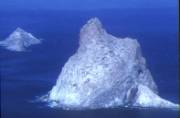
What is it?
Roques de Anaga Nature Reserve is located within Anaga Country Park and consists of two enormous, well-preserved rocks: the Roque de Tierra (“Earth Rock”, also sometimes known as the Roque de Dentro, or “Inside Rock”) and the Roque de Fuera (“Outside Rock”). Together they comprise an ecosystem that is one of the most representative of the Canary Islands, and are therefore of significant scientific, geological and geomorphological interest, as well as being of immense value in landscape terms.
The Nature Reserve has an impressive population of vertebrates, including a variety of endemic species. Some of these, such as the Anaga lizard (Gallotia galloti insulanagae), have only ever been found in this area. The Reserve is also an important nesting site for a number of bird species, such as Bulwer's petrel (Bulweria bulwerii), the Madeiran storm petrel (Oceanodroma castro) and Cory's shearwater (Calonectris diomedea). Plant life, meanwhile, consists of species that are broadly xerophytic or halophilous in nature. The peak of the Roque de Tierra is home to a spectacular copse of Canary Island dragon trees, containing almost a hundred individual trees, and there are also traces of an earlier forest of Phoenician juniper (Juniperus phoenicia) which may have been cut down in the 1930s. The 65 species of vascular plant found on the rocks include a number of unusual examples such as the Convolvulus fruticulosus species of bindweed, Haworth's aeonium (Aeonium haworthii) and the threatened parrot's beak (Lotus maculatus), which is extremely numerous on the Roque de Tierra.
Getting there
As the legislation pertaining to the conservation of protected natural areas prohibits human entry to nature reserves for non-scientific purposes, information on how to access the park cannot be provided.
Total area
10 ha.
Municipality
Santa Cruz de Tenerife
Governing legislation
Roques de Anaga was declared a Nature Reserve and area of environmental sensitivity by Autonomous Region Act 12/94, which was later integrated into the Organisation of the Canary Islands Territory Act via Legislative Decree 1/2000.

 Print
Print